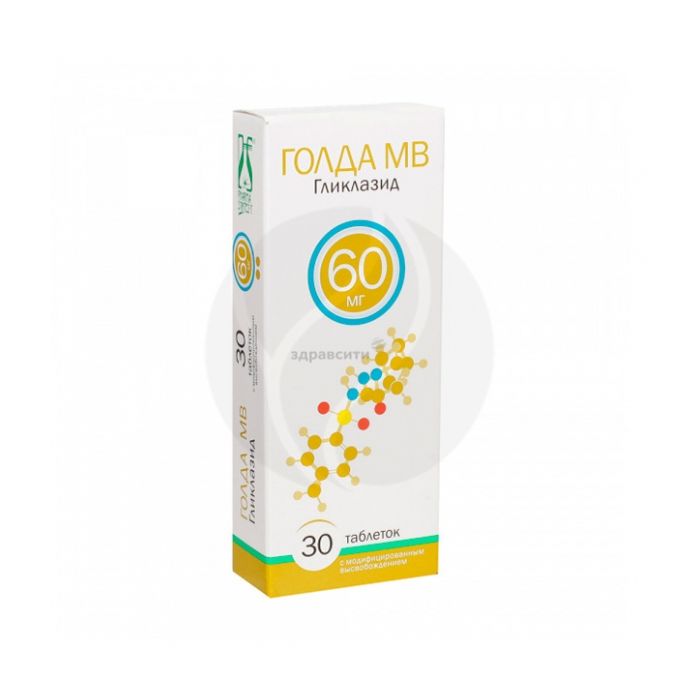Golda MV tablets 60mg, No. 30
Russian Pharmacy name:
Голда МВ таблетки 60мг, №30
Diabetes mellitus type 2 with insufficient effectiveness of diet therapy, exercise and weight loss.
Prevention of complications of type 2 diabetes mellitus: reducing the risk of microvascular (nephropathy, retinopathy) and macrovascular complications (myocardial infarction, stroke).
The initial daily dose is 80 mg, the average daily dose is 160-320 mg, the frequency of administration is 2 times / day before meals. Dosing is individual, depending on fasting blood glucose and 2 hours after meals, as well as on the clinical manifestations of the disease.
Modified release tablets
1 tab. gliclazide
Excipients: lactose monohydrate, hypromellose 2208, sodium carboxymethyl starch type C, magnesium stearate, colloidal silicon dioxide.
Type 1 diabetes mellitus (insulin dependent), ketoacidosis, diabetic precoma and coma, severe renal and / or hepatic failure;
pregnancy, breastfeeding period;
children and adolescents up to 18 years old;
hypersensitivity to sulfonylurea derivatives and sulfonamides.
Simultaneous use of gliclazide and imidazole derivatives (including miconazole).
pharmachologic effect
Oral hypoglycemic agent, sulfonylurea derivative of the second generation. Stimulates insulin secretion by? -Cells of the pancreas. Increases the sensitivity of peripheral tissues to insulin. Apparently, it stimulates the activity of intracellular enzymes (in particular, muscle glycogen synthetase). Reduces the time from the moment you eat to the start of insulin secretion. Restores the early peak of insulin secretion, reduces the postprandial peak of hyperglycemia.
Gliclazide reduces platelet adhesion and aggregation, slows down the development of parietal thrombus, increases vascular fibrinolytic activity. Normalizes vascular permeability. It has anti-atherogenic properties: it lowers the concentration of total cholesterol (Ch) and Ch-LDL in the blood, increases the concentration of Ch-HDL, and also reduces the amount of free radicals. Prevents the development of microthrombosis and atherosclerosis. Improves microcirculation. Reduces the sensitivity of blood vessels to adrenaline.
With diabetic nephropathy against the background of long-term use of gliclazide, there is a significant decrease in proteinuria.
Pharmacokinetics
After oral administration, it is rapidly absorbed from the gastrointestinal tract. Cmax in the blood is reached approximately 4 hours after taking a single dose of 80 mg.
Plasma protein binding is 94.2%. Vd - about 25 l (0.35 l / kg body weight).
It is metabolized in the liver to form 8 metabolites. The main metabolite does not have a hypoglycemic effect, but it affects microcirculation.
T1 / 2 - 12 hours. It is excreted mainly by the kidneys in the form of metabolites, less than 1% is excreted in the urine unchanged.
Side effect
From the digestive system: rarely - anorexia, nausea, vomiting, diarrhea, epigastric pain.
From the hematopoietic system: in some cases - thrombocytopenia, agranulocytosis or leukopenia, anemia (usually reversible).
From the endocrine system: in case of overdose - hypoglycemia.
Allergic reactions: skin rash, itching.
Application during pregnancy and lactation
Use during pregnancy and breastfeeding is contraindicated.
Application for violations of liver function
Use is contraindicated in severe hepatic impairment.
Application for impaired renal function
Use is contraindicated in severe renal failure.
Application in children
Contraindicated for use in children and adolescents under the age of 18 years.
Use in elderly patients
Use with caution in elderly patients.
special instructions
Gliclazide is used to treat non-insulin dependent diabetes mellitus in combination with a low-calorie, low-carbohydrate diet.
During treatment, you should regularly monitor fasting blood glucose levels and after meals, daily fluctuations in glucose levels.
In the case of surgical interventions or decompensation of diabetes mellitus, it is necessary to consider the possibility of using insulin preparations.
With the development of hypoglycemia, if the patient is conscious, glucose (or sugar solution) is administered orally. In case of loss of consciousness, glucose is administered intravenously or glucagon s / c, intramuscularly or intravenously. After the restoration of consciousness, it is necessary to give the patient food rich in carbohydrates in order to avoid the re-development of hypoglycemia.
With the simultaneous use of gliclazide with verapamil, regular monitoring of blood glucose levels is necessary; with acarbose - careful monitoring and correction of the dosage regimen of hypoglycemic agents is required.
The simultaneous use of gliclazide and cimetidine is not recommended.
Drug interactions
The hypoglycemic effect of gliclazide is potentiated when used simultaneously with pyrazolone derivatives, salicylates, phenylbutazone, antibacterial sulfa drugs, theophylline, caffeine, MAO inhibitors.
Simultaneous use with non-selective beta-blockers increases the likelihood of hypoglycemia, and can also mask tachycardia and hand tremors, characteristic of hypoglycemia, sweating may increase.
With the simultaneous use of gliclazide and acarbose, an additive hypoglycemic effect is observed.
Cimetidine increases the concentration of gliclazide in plasma, which can cause severe hypoglycemia (depression of the central nervous system, impaired consciousness).
With simultaneous use with corticosteroids (including dosage forms for external use), diuretics, barbiturates, estrogens, progestins, combined estrogen-gestagenic drugs, diphenin, rifampicin, the hypoglycemic effect of gliclazide decreases.

